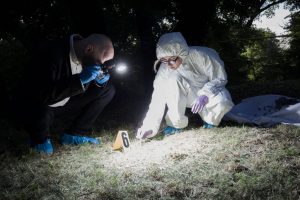
Crime scenes aren’t pretty, but in the eyes of CSIs, they’re a bounty of evidence waiting to be harvested. Identifying, preserving, and collecting evidence at the crime scene remain their sole focus. Using the skills they’ve acquired and honed through careers in law enforcement and training in forensic science, they maintain the integrity of the evidence that gets collected to ensure it paints a clear and true portrait of the crime that took place there.
Earning potential in crime scene investigations tends to be strong, but the higher salaries almost always go to professionals with more formal education and those within larger police agencies. This is a career where earning your dues is a must and higher education is a basic expectation, but with the right training and time in the field, you can expect some handsome paychecks.
Salaries for Crime Scene Investigators
Salaries for CSIs in the FBI’s Evidence Response Team
Salaries for Crime Scene Investigators, by State
Salaries for Crime Scene Investigators

According to the U.S. Bureau of Labor Statistics (BLS), crime scene investigators (classified by BLS in a broader category inclusive of forensic science technicians, crime scene analysts, and criminalists) earned an average salary of $59,150 as of May 2019. The top earners in the field (top 10%) earned $97,350 during this time.
The Role Experience, Education, and Industry Play in CSI Salaries
Most crime scene investigators above the technician level are mid-career professionals who have paid their dues in law enforcement as police officers. This means most CSIs are sworn officers with at least a handful of years of experience, and in many smaller police departments, they often hold the dual title of police officer/crime scene investigator.
A lack of consistency in the professional ranks from department to department can make it a bit difficult to pinpoint accurate salaries at different levels, but what emerges from the data is the fact that those with more advanced degrees almost always bring home bigger paychecks than their colleagues with associate’s degrees or certificates in crime scene investigations. Professionals with bachelor’s degrees in a field related to forensic science remain the most sought after in the profession, while senior leaders and supervisors often have graduate degrees in areas like forensic chemistry, forensic science, and biomedical forensic science front and center on their resume.
Experience also remains a big factor when it comes to earning potential in the field. For example, a police officer with a decade of experience will naturally earn more as a crime scene investigator than someone who’s been in law enforcement for just a few years. Similarly, someone who’s earned their stripes as a crime scene investigator and has a long history of outstanding crime scene work will demand a higher salary than someone who’s relatively new to the field.
You’ll find some variation among CSI salaries based on location, usually due to cost of living differences. For example, it comes as no surprise that the BLS reports California as the top-paying state in the nation for crime scene investigators, with an annual, mean salary of $87,200. Other states that come out on top for average pay include:
- Illinois: $82,130
- Massachusetts: $76,950
- Alaska: $72,380
- Virginia: $69,260
The biggest difference in pay can be attributed to the size of the agency employer, whether it’s directly with a state or county agency or regional crime lab. Again, no surprise here: many of the nation’s largest metro areas which, of course, are home to some of the largest police agencies and crime labs, come out on top for CSI pay:
- San Francisco, CA (also include Oakland and Hayward): $103,940
- Oxnard, CA (also include Thousand Oaks and Ventura): $91,790
- Sacramento, CA (also includes Roseville, Arden, and Arcade): $90,670
- Toledo, OH: $85,320
- Washington D.C. (also includes Arlington and Alexandria, VA): $85,140
- Boston, MA (includes Cambridge): $82,850
Of course, you’ll find salary differences between CSIs working for federal, state, and local agencies too. For example, BLS stats show that federal CSIs with the FBI and other federal law enforcement agencies earned an annual, mean salary of $111,180 as of May 2019, while those in state and local police agencies earned $62,470 and $64,700, respectively.
Salaries for CSIs in the FBI’s Evidence Response Team

Crime scene investigators in the FBI (called special agents, logistic management specialists, forensic operations specialists, and more) are part of the Evidence Response Team (ERT) program, which has teams in all 56 FBI field offices. These forensic teams descend upon what the FBI refers to as “complex crime scenes and catastrophic world events” to collect and preserve evidence. Plane crashes, bombings, terrorist events, and the like are all in the realm of the work of the ERT.
They are national and world leaders in crime scene processing and must adhere to the highest standards of safety, expertise, equipment, training, and capability. Land a job in the FBI’s ERT and chances are you’ll be counted among the highest paid crime scene investigators in the country.
While education and experience requirements vary based on the position, you’ll be expected to have experience in a number of areas, such as evidence recovery, preservation procedures, investigative and operational methods. Specialty positions within the ERT include working with hazardous materials and require skills related to maritime, swift water, dive support, trenching, and shoring.
As a governmental agency, the FBI follows the General Schedule (GS)-the pay scale for all federal employees. The GS features 15 pay grades (G-1 to G-15) and ten pay steps within each grade. Based on the most current FBI information, positions with the ERT start at the GS-9 level, with higher salaries based on education and experience.
The 2020 GS schedule is as follows:
- GS-9: $45,627 – $59,316
- GS-10: $50,246 – $65,321
- GS-11: $55,204 – $71,764
- GS-12: $66,167 – $86,021
- GS-13: $78,681 – $102,288
- GS-14: $92,977 – $120,868
- GS-15: $109,366 – $142,180
Salaries for Crime Scene Investigators, by State

Learn more about what crime scene investigators in your state were earning at the 50th and 90thpercentiles, as of May 2019 (U.S. Bureau of Labor Statistics):
- Alabama: $47,400 – $62,000 (approximately 160 forensic science technicians)
- Alaska: $69,480 – $97,740 (approximately 50 forensic science technicians)
- Arizona: $58,830 – $92,000 (approximately 700 forensic science technicians)
- Arkansas: $45,970 – $53,560 (approximately 160 forensic science technicians)
- California: $82,070 – $130,030 (approximately 2,150 forensic science technicians)
- Colorado: $65,040 – $93,620 (approximately 330 forensic science technicians)
- Connecticut: $71,980 – $90,960 (approximately 110 forensic science technicians)
- Florida: $52,480 – $78,980 (approximately 1,680 forensic science technicians)
- Georgia: $45,630 – $75,690 (approximately 560 forensic science technicians)
- Hawaii: $55,070 – $76,040 (approximately 80 forensic science technicians)
- Illinois: $89,400 – $102,150 (approximately 410 forensic science technicians)
- Indiana: $62,760 – $86,980 (approximately 380 forensic science technicians)
- Kansas: $49,040 – $74,150 (approximately 400 forensic science technicians)
- Kentucky: $46,370 – $70,560 (approximately 70 forensic science technicians)
- Louisiana: $45,600 – $78,020 (approximately 230 forensic science technicians)
- Maine: $61,290 – $71,240 (approximately 30 forensic science technicians)
- Maryland: $63,500 – $108,990 (approximately 440 forensic science technicians)
- Massachusetts: $74,700 – $118,040 (approximately 80 forensic science technicians)
- Michigan: $69,810 – $94,040 (approximately 360 forensic science technicians)
- Minnesota: $60,070 – $89,580 (approximately 90 forensic science technicians)
- Mississippi: $50,680 – $66,180 (approximately 110 forensic science technicians)
- Missouri: $52,310 – $75,790 (approximately 350 forensic science technicians)
- Montana: $68,320 – $79,170 (approximately 50 forensic science technicians)
- Nebraska: $52,420 – $71,930 (approximately 110 forensic science technicians)
- Nevada: $62,650 – $98,340 (approximately 380 forensic science technicians)
- New Hampshire: $72,810 – $82,870 (approximately 50 forensic science technicians)
- New Jersey: $57,750 – $96,990 (approximately 100 forensic science technicians)
- New Mexico: $36,830 – $78,660 (approximately 240 forensic science technicians)
- New York: $65,030 – $93,500 (approximately 860 forensic science technicians)
- North Carolina: $45,700 – $65,520 (approximately 440 forensic science technicians)
- Ohio: $66,630 – $92,380 (approximately 460 forensic science technicians)
- Oklahoma: $58,340 – $80,600 (approximately 210 forensic science technicians)
- Oregon: $70,910 – $85,880 (approximately 250 forensic science technicians)
- Pennsylvania: $47,930 – $76,230 (approximately 300 forensic science technicians)
- South Carolina: $39,410 – $61,060 (approximately 150 forensic science technicians)
- South Dakota: $35,300 – $62,600 (approximately 40 forensic science technicians)
- Tennessee $51,150 – $78,340 (approximately 510 forensic science technicians)
- Texas: $52,670 – $84,110 (approximately 1,480 forensic science technicians)
- Virginia: $67,230 – $106,670 (approximately 440 forensic science technicians)
- Washington: $64,580 – $86,860 (approximately 400 forensic science technicians)
- West Virginia: $41,420 – $67,280 (approximately 110 forensic science technicians)
- Wisconsin: $52,110 – $86,370 (approximately 250 forensic science technicians)
- Wyoming: $50,370 – $79,150 (approximately 50 forensic science technicians)
Salary and employment data compiled by the United States Department of Labor’s Bureau of Labor Statistics in May of 2019. Figures represent accumulated data for all employment sectors in which forensic science technicians work. BLS salary data represents average and median earnings for the occupations listed and includes workers at all levels of education and experience. This data does not represent starting salaries.
All salary and employment data accessed August 2020.






